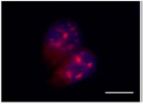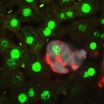(Press-News.org) When we talk about genetic material, we are usually referring to the DNA (deoxyribonucleic acid) that we inherit from our parents. This DNA is the factory where is built a similar molecule called RNA (ribonucleic acid) which produces our proteins, such as hemoglobin or insulin , allowing the lives of our cells. But there is a special group called non-coding RNA that has a more enigmatic function.
The best known is microRNAs, tiny molecules that are responsible for turning on or off our genome like an electrical current switch. Today, an article published in the prestigious journal Molecular Cell by Manel Esteller, Director of Epigenetics and Cancer Biology Program of the Bellvitge Biomedical Research Institute (IDIBELL), ICREA researcher and Professor of Genetics at the University of Barcelona, provides a twist over this mystery.
Research shows that there is a second type of non-coding RNA, called ultra-conserved RNA that acts as switches switch, ie , controls the activity of microRNAs.
"Who watches the watchers? This was one of the issues that we set at the beginning of the research" says Esteller. "We have found that special molecules called ultra-conserved RNA were not produced in human tumors and this contributed to their growth, but we knew nothing about this mechanism. It should be an important role because these molecules are highly conserved in evolution and there is no variation from chickens to humans. We realized ultraconservated RNAs attached to the other family of non-coding RNAs , microRNAs, as a magnet and prevented its function. That is, they are the police internal affairs officers who supervise the battle soldiers in healthy cells . If a cell fails to produce the ultraconservated RNA, microRNA gets altered and hundreds of genes that should maintain cellular balance does and thus contributes to the formation of human tumors, " concludes Manel Esteller.
The results obtained by the group Esteller in Molecular Cell article are very important for understanding the function of the dark genome. Deciphering encrypted codes of cellular activity in these sequences of our DNA represents one of the most exciting challenges of modern biology. This cutting edge research is beginning to bear its first fruits in the field of medical research such as that described ultraconservated RNA is related with cancer development.
INFORMATION: END
Discovered a new way to control genetic material altered in cancer
2014-06-05
ELSE PRESS RELEASES FROM THIS DATE:
A new model of liver regeneration
2014-06-05
Harvard Stem Cell Institute scientists at Boston Children's Hospital have new evidence in mice that it may be possible to repair a chronically diseased liver by forcing mature liver cells to revert back to a stem cell-like state.
The researchers, led by Fernando Camargo, PhD, happened upon this discovery while investigating whether a biochemical cascade called Hippo, which controls how big the liver grows, also affects cell fate. The unexpected answer, published in the journal Cell, is that switching off the Hippo-signaling pathway in mature liver cells generates very ...
Vanderbilt scientists discover that chemical element bromine is essential to human life
2014-06-05
Twenty-seven chemical elements are considered to be essential for human life.
Now there is a 28th – bromine.
In a paper published Thursday by the journal Cell, Vanderbilt University researchers establish for the first time that bromine, among the 92 naturally-occurring chemical elements in the universe, is the 28th element essential for tissue development in all animals, from primitive sea creatures to humans.
"Without bromine, there are no animals. That's the discovery," said Billy Hudson, Ph.D., the paper's senior author and Elliott V. Newman Professor of Medicine.
The ...
Flowers' polarization patterns help bees find food
2014-06-05
Like many other insect pollinators, bees find their way around by using a polarization sensitive area in their eyes to 'see' skylight polarization patterns. However, while other insects are known to use such sensitivity to identify appropriate habitats, locate suitable sites to lay their eggs and find food, a non-navigation function for polarization vision has never been identified in bees – until now.
Professor Julian Partridge, from Bristol's School of Biological Sciences and the School of Animal Biology at the University of Western Australia, with his Bristol-based ...
Stem cells hold keys to body's plan
2014-06-05
Case Western Reserve researchers have discovered landmarks within pluripotent stem cells that guide how they develop to serve different purposes within the body. This breakthrough offers promise that scientists eventually will be able to direct stem cells in ways that prevent disease or repair damage from injury or illness. The study and its results appear in the June 5 edition of the journal Cell Stem Cell.
Pluripotent stem cells are so named because they can evolve into any of the cell types that exist within the body. Their immense potential captured the attention ...
Couples sleep in sync when the wife is satisfied with their marriage
2014-06-05
DARIEN, IL – A new study suggests that couples are more likely to sleep in sync when the wife is more satisfied with their marriage.
Results show that overall synchrony in sleep-wake schedules among couples was high, as those who slept in the same bed were awake or asleep at the same time about 75 percent of the time. When the wife reported higher marital satisfaction, the percent of time the couple was awake or asleep at the same time was greater.
"Most of what is known about sleep comes from studying it at the individual level; however, for most adults, sleep is a ...
The connection between oxygen and diabetes
2014-06-05
Researchers at the University of California, San Diego School of Medicine have, for the first time, described the sequence of early cellular responses to a high-fat diet, one that can result in obesity-induced insulin resistance and diabetes. The findings, published in the June 5 issue of Cell, also suggest potential molecular targets for preventing or reversing the process.
"We've described the etiology of obesity-related diabetes. We've pinpointed the steps, the way the whole thing happens," said Jerrold M. Olefsky, MD, associate dean for Scientific Affairs and Distinguished ...
Investors' risk tolerance decreases with the stock market, MU study finds
2014-06-05
COLUMBIA, Mo — As the U.S. economy slowly recovers many investors remain wary about investing in the stock market. Now, Michael Guillemette, an assistant professor of personal financial planning in the University of Missouri College of Human Environmental Sciences, analyzed investors' "risk tolerance," or willingness to take risks, and found that it decreased as the stock market faltered. Guillemette says this is a very counterproductive behavior for investors who want to maximize their investment returns.
"At its face, it seems fairly obvious that investors would be ...
What a 66-million-year-old forest fire reveals about the last days of the dinosaurs
2014-06-05
This news release is available in French.
As far back as the time of the dinosaurs, 66 million years ago, forests recovered from fires in the same manner they do today, according to a team of researchers from McGill University and the Royal Saskatchewan Museum.
During an expedition in southern Saskatchewan, Canada, the team discovered the first fossil-record evidence of forest fire ecology - the regrowth of plants after a fire - revealing a snapshot of the ecology on earth just before the mass extinction of the dinosaurs. The researchers also found evidence that ...
University of Toronto biologists pave the way for improved epilepsy treatments
2014-06-05
TORONTO, ON – University of Toronto biologists leading an investigation into the cells that regulate proper brain function, have identified and located the key players whose actions contribute to afflictions such as epilepsy and schizophrenia. The discovery is a major step toward developing improved treatments for these and other neurological disorders.
"Neurons in the brain communicate with other neurons through synapses, communication that can either excite or inhibit other neurons," said Professor Melanie Woodin in the Department of Cell and Systems Biology at the ...
Use of gestures reflects language instinct in young children
2014-06-05
Young children instinctively use a "language-like" structure to communicate through gestures, according to research published in Psychological Science, a journal of the Association for Psychological Science.
The research, led by the University of Warwick, shows that when young children are asked to use gestures to communicate, their gestures segment information and reorganize it into language-like sequences.
This finding suggests that children are not just learning language from older generations — their own preferences in communication may have shaped how languages ...


